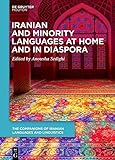Iranian and Minority Languages at Home and in Diaspora / ed. by Anousha Sedighi.
Material type: TextSeries: The Companions of Iranian Languages and Linguistics [CILL] ; 1Publisher: Berlin ; Boston : De Gruyter Mouton, [2023]Copyright date: ©2023Description: 1 online resource (XII, 409 p.)Content type:
TextSeries: The Companions of Iranian Languages and Linguistics [CILL] ; 1Publisher: Berlin ; Boston : De Gruyter Mouton, [2023]Copyright date: ©2023Description: 1 online resource (XII, 409 p.)Content type: - 9783110694130
- 9783110694314
- 9783110694277
- 491/.5 23//eng/20230303eng
- online - DeGruyter
- Issued also in print.
| Item type | Current library | Call number | URL | Status | Notes | Barcode | |
|---|---|---|---|---|---|---|---|
 eBook
eBook
|
Biblioteca "Angelicum" Pont. Univ. S.Tommaso d'Aquino Nuvola online | online - DeGruyter (Browse shelf(Opens below)) | Online access | Not for loan (Accesso limitato) | Accesso per gli utenti autorizzati / Access for authorized users | (dgr)9783110694277 |
Frontmatter -- Acknowledgements -- Foreword -- Contents -- 1 Introduction -- Part I: Iranian Minority Languages -- 2 At the Crossroads: Caspian Languages through a Sociolinguistic Lens -- 3 Mazandarani: Current Status and Future Prospects -- 4 Balochi: Literary Development, Status and Vitality -- 5 Attitudes Towards Tati Language Among its Native Speakers in Western Iran -- 6 The Bakhtiari Language: Maintenance or Shift? A Diachronic Survey on the Status of Bakhtiari in the City of Masjed Soleiman between 1996–2020 -- Part II: Non-Iranian Minority Languages -- 7 Ebb and Flow of Azeri and Persian in Iran: A Longitudinal Study in the City of Zanjan -- 8 Language Shift and Language Maintenance among Turkmen Speakers -- 9 Language Change and Maintenance among Mandaic Speakers of Iran: A Socio-linguistic Study -- 10 Armenian Language and Identity in Iran: The Case of Iranian Armenians of Isfahan -- Part III: Iranian Heritage Languages in Diaspora -- 11 Wakhi in New York: Multilingualism and Language Contact in a Pamiri Diaspora Community -- 12 Language Maintenance and Language Shift: A Perspective from the First- Generation and Second-Generation Pashto Speakers Living in the United States and Canada -- 13 Persian as a Diasporic Language in the United States: A Survey of Heritage Persian Learners at College Level -- Index
restricted access online access with authorization star
http://purl.org/coar/access_right/c_16ec
While the typology, syntax, and morphology of Iranian languages have been widely explored, the sociolinguistic aspects remain largely understudied. The present companion addresses this essential yet overlooked area of research in two ways: (i) The book explores multilingualism within Iran and its neighbouring countries. (ii) It also investigates Iranian heritage languages within the diasporic context of the West. The scope of languages covered is vast: In addition to discussing Iranian minority languages such as Tati and Balochi, the book explores non-Iranian minority languages such as Azeri, Tukmen, Armenian and Mandaic. Furthermore, the companion investigates Iranian heritage languages such as Wakhi, Pashto, and Persian within their diasporic and global contexts. In the current era of migration and globalization, minority and heritage speakers are increasingly valuable resources. By focusing on the speakers, the companion provides new insights into a multitude of sociolinguistic issues including language attitude and identity, language use and literacy practices, language policy, language shift and loss. The companion is an essential reference for those interested in Iranian languages, minority languages, heritage languages, sociolinguistics, bilingualism, language policy and planning, diaspora and migration studies, as well as those researching in related fields.
Issued also in print.
Mode of access: Internet via World Wide Web.
In English.
Description based on online resource; title from PDF title page (publisher's Web site, viewed 25. Jun 2024)


